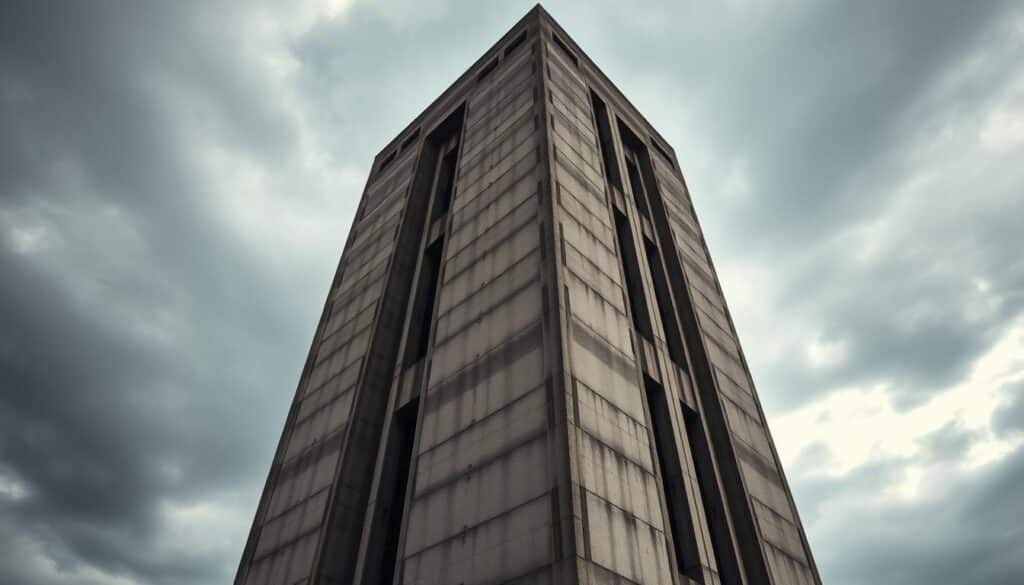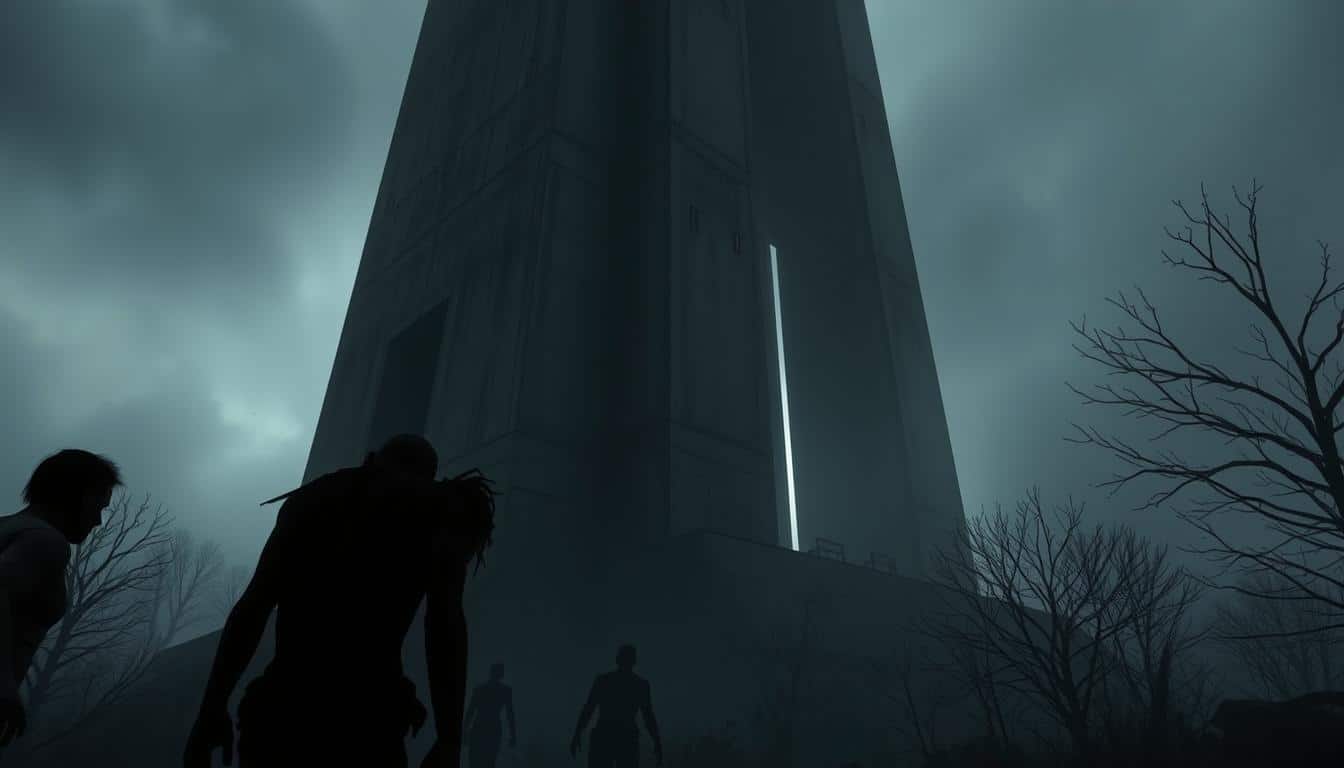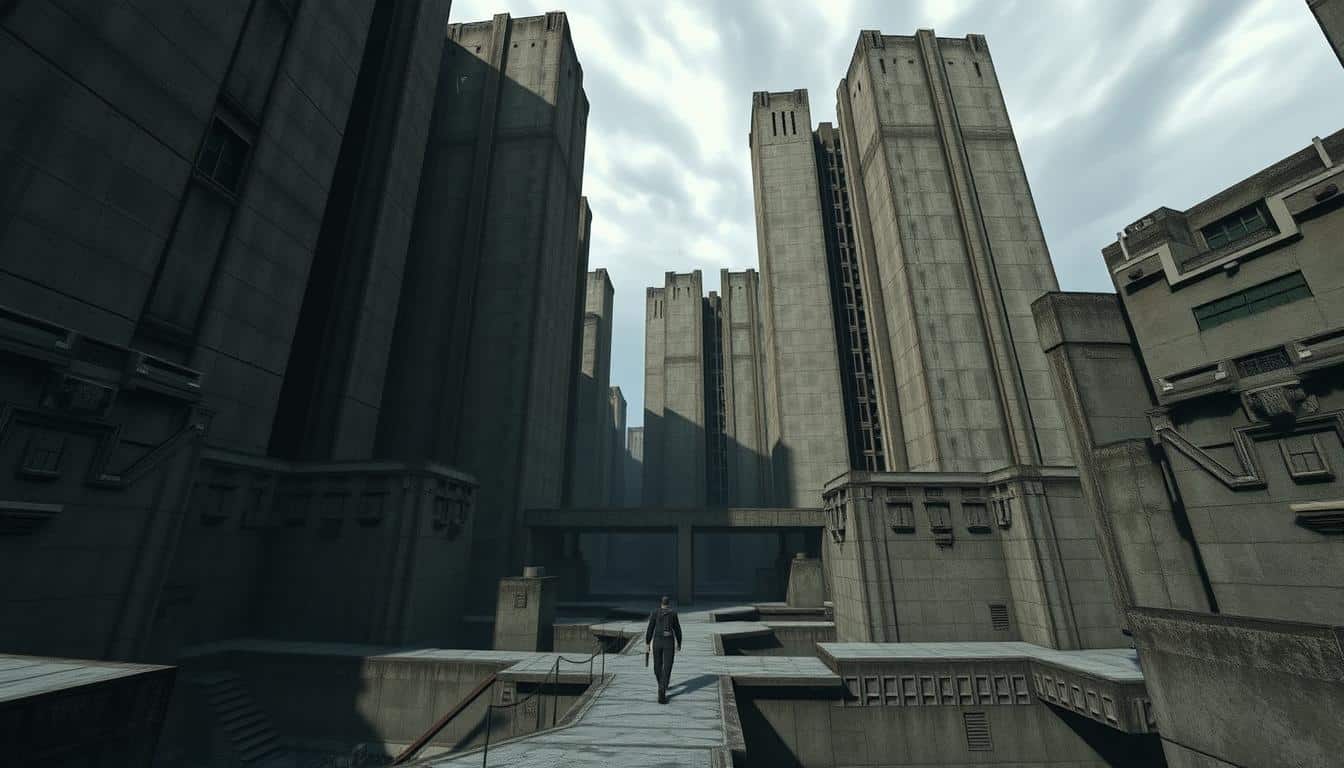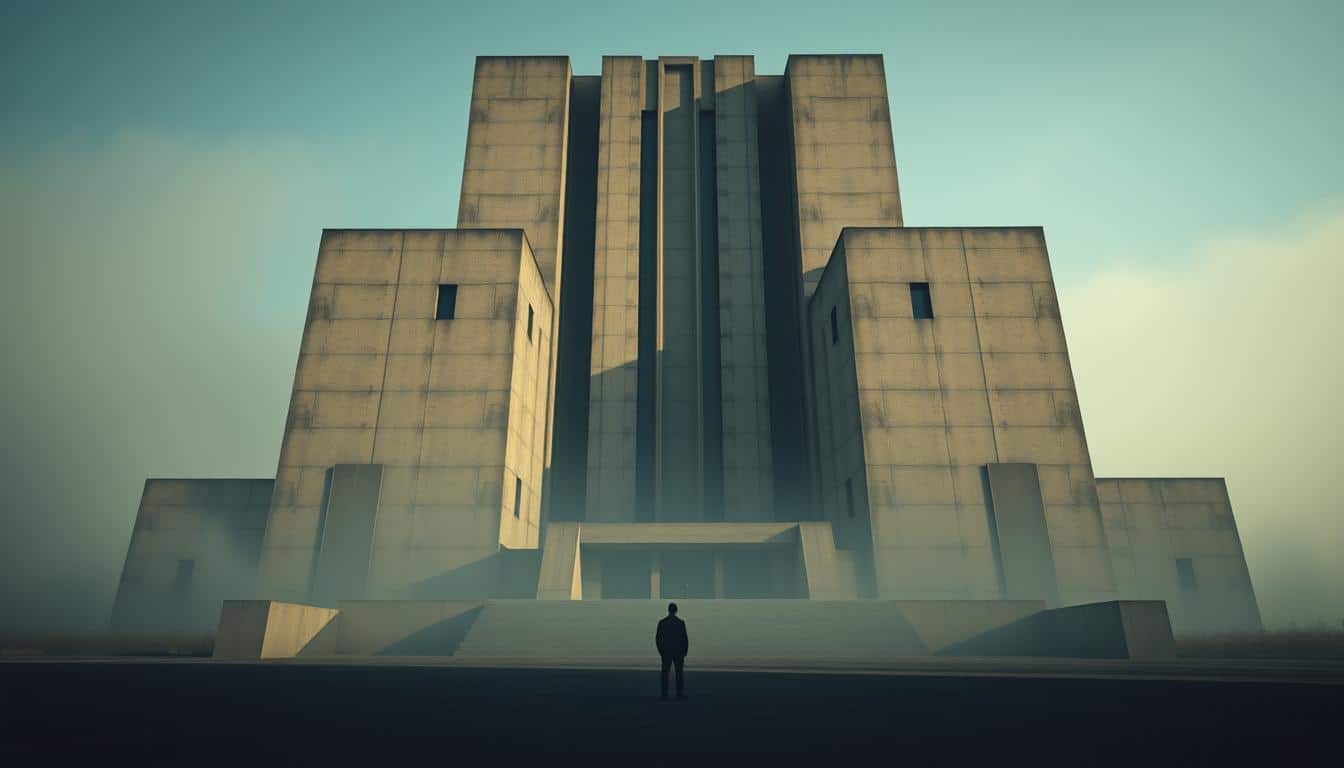Combining Soviet Brutalism with video game design shows how architecture can shape our gaming worlds. Born in a stark historical moment, Soviet Brutalism stands out with its bold, bare buildings and focus on function. When game creators tap into this style, they craft spaces that really speak to players on different levels.
This piece explores how Soviet Brutalism shapes video game design. It sets up a deep dive into how these architectural ideas play out in games.
Introduction to Soviet Brutalism
Soviet Brutalism became a big deal in architecture after the war. It mixed practical design with a strong message. Mainly using raw concrete, it showed off a simple, bold look. Unlike the fancy styles before it, it loved geometric shapes and useful buildings.
This style started in the Soviet Union’s unique social and political climate. The government wanted architecture to show off a new socialist life. Soviet Brutalism was about making spaces for people that were simple but strong. It aimed to create buildings that were tough and powerful, just like the Soviet state itself.

The Roots of Soviet Architecture
Soviet architecture started from a mix of history and culture changes. The early 20th century saw a big shift in how buildings were made. Architects wanted to create a new look for society after the revolution.
The rise of Constructivism was a key change. This style focused on the building’s use and the materials used. It moved away from fancy decoration of the past.
Due to political changes, architects aimed to show socialist goals through their buildings. Buildings showed progress and community life. They were meant to help people interact and share a common identity.
Later, Brutalism came as a new trend. It used basic materials and simple shapes. This was different from earlier styles. This change not only transformed cities but also left a lasting mark on design. It influenced many styles and still inspires people today.
Soviet Brutalism Architectural Influences in Gaming
The unique style of Soviet Brutalism has made a big impact on game design. Its use of simple materials and bold shapes fits perfectly into video games. These features help create immersive worlds. They connect players to the history behind this architectural style.
Understanding the Aesthetic
Soviet Brutalism is all about being plain and powerful. This look is also seen in many video games. The rough textures of concrete, the clear geometric shapes, and large, open areas reflect Brutalism’s key traits. This helps make games feel real and connected to a certain culture.
Examples in Popular Video Games
Some games really show off Soviet Brutalism. For example, “S.T.A.L.K.E.R.: Shadow of Chernobyl” has a lot of these architectural styles. This adds a layer of realness to the game. “Metro Exodus” also uses this style to create a world after a big disaster. It draws players into a place that feels inspired by real Soviet buildings.
Case Study: Tower Block Tetris
Tower Block Tetris brings a new twist to classic Tetris by using Soviet-era architecture. It’s made by Lukas Valiauga for mobile phones. Players build with concrete housing blocks instead of Tetriminos. This new twist on the game brings up thoughts on city living and history.
Overview of the Game Concept
The game keeps the core puzzle mechanics of Tetris but with a special design. The blocks look like Soviet apartment buildings. This design makes playing the game not just fun, but also a way to think about urban design.
Architectural References in Gameplay
The game’s look is inspired by Brutalist architecture. As players stack blocks, they also learn about history. The game mixes fun with a chance to think about housing and community.
The Evolution of Brutalism in Digital Spaces
Brutalism has evolved from concrete buildings to digital spaces. This change combines the architecture’s stark style with the depth of virtual worlds. This way, game makers have brought the strong, bare look of Brutalism into their designs. So, gamers find themselves in worlds that test how they see things and touch deeper feelings of awareness and social thoughts.
Moving Brutalism into the digital world means seeing how design shapes gaming feelings. These places focus on simple shapes and looks, often showing off the raw look of concrete. By mixing digital textures and light, they make these spaces feel real. This helps players connect deeply with the world’s architecture as it changes around them.
The mix of raw Brutalism and modern gaming makes a special kind of beauty. The bold edges and useful shapes break the usual design rules. This shift in how we view game spaces is not just a visual change. It also critiques the nature of virtual worlds. That makes Brutalism a fascinating idea in video games today.
Transformative Impact of Brutalism on Game Design
Soviet Brutalism gives game design a fresh twist. It influences both the look of digital worlds and how games play. By adding Brutalist styles, games gain unique settings that change how players act and plan.
Architectural Features as Gameplay Mechanics
Games often turn Brutalism’s bold shapes and huge spaces into key gameplay elements. These aspects guide the game’s flow, shaping how players move and interact. Features include:
- Big concrete blocks that act as shields or hurdles, impacting choices in battle
- Wide plazas that invite players to explore and find secrets
- High areas that introduce new strategies, like climbing
These designs pull players in while challenging them to think of new tactics. They mirror the raw appeal of Brutalist architecture, presenting gamers with unique puzzles.
Storytelling Through Architectural Elements
Game stories gain depth from Brutalism’s stark looks. This style can express feelings of loneliness, control, or strength. Using spaces cleverly helps tell richer stories. Examples include:
- Playing with shadows and light in concrete settings to create eeriness
- Places that hint at history, adding layers to the story
- Maze-like buildings that represent confusion and challenge in the plot
The mix of play tactics and Brutalist elements boosts the gaming experience. It draws players deeper into the game’s world, showing how Brutalism’s inspiration is changing game landscapes.
Notable Video Games Inspired by Soviet Brutalism
Many video games draw inspiration from Soviet Brutalism. They use this unique style to create special settings. This makes the game world feel more real and interesting for the players. Players get to see how Soviet architecture influences the game’s look and story.
Analyzing Architectural Styles in Major Titles
“S.T.A.L.K.E.R.” and “The Last of Us” show Soviet Brutalism in their game worlds. This style makes these places look real and adds to the fun. Players see raw concrete, huge structures, and symmetrical designs.
This way of building adds a lot to the game’s story. It sets the mood for the adventures players go on.
Community-Driven Design Initiatives
Gamers often work on projects that highlight Soviet Brutalism. They make mods and maps that show off this architecture. This lets players see new, history-rich places in their favorite games. Some top projects are:
- Mods that build famous brutalist buildings in games
- Maps that have key Soviet architecture features
- Contests that mix gaming with architecture design
These projects show how much gamers like Soviet Brutalism. They help start conversations about architecture’s role in games.
The Intersection of Architecture and Gameplay
How players move and engage in video games is hugely influenced by architecture and gameplay integration. The design focuses on making game worlds feel real, making how spaces are arranged very important. Buildings in games do more than look nice; they shape how we move and interact in these worlds.
Games use architecture to make their worlds feel more real and engaging. When a game mirrors real-life design, it can make us feel a deep connection to its spaces. Things like how buildings are laid out, lighting, and object placement help tell a game’s story. They let us live out stories in unique and personal ways.
Global Implications of Brutalism in Game Environments
Brutalism is now a big deal in game design. It started in Eastern Europe but now influences games all over the world. This style is all about raw, functional looks. It inspires game makers to create new kinds of spaces and stories. As games keep evolving, Brutalism shows up in many projects. It shows us how buildings can tell stories about society and politics.
Influences Beyond Eastern Europe
Brutalism has reached far beyond Eastern Europe. Game developers in North America, Asia, and other places are taking notice. The influence shows up in many ways:
- Using Brutalist design in city settings makes games feel more real and can reflect social issues.
- Games use architecture to tell stories about the real world. Brutalism helps make those stories deeper.
- Games are mixing Brutalist style with local designs. This creates new and interesting game worlds.
Future Trends in Game Design Inspired by Architecture
The future of game design looks bright with Brutalism in the mix. Here’s what might happen next:
- Gaming environments could use modular designs more. This means players can move through games in many ways, all thanks to architecture.
- There might be more teamwork between game makers and architects. They can show how Brutalism shapes fun and interactive experiences.
- Games might focus more on being green and fixing up cities. These stories would mirror what’s happening in architecture today.
Challenges and Critiques of Brutalist Design in Games
Brutalist design brings unique challenges and critiques in video games. One main issue is how its stark, angular buildings look. Many players think Brutalist architecture looks harsh. This leads to discussions on if it attracts or turns away players.
There’s another challenge with making Brutalist design work in gameplay. Developers need to mix realism with keeping players interested. They create worlds that are immersive yet functional. Some critiques point out that stiff, large spaces can limit players’ freedom. This could make the gaming experience less fun.
Even with its boldness, Brutalist design might make games feel empty or dull, as players move through huge, bare areas. Players often prefer environments that make them feel something. Thus, it’s key for designers to think about how architecture affects the story.
- Challenges include:
- Balancing aesthetic appeal with functionality
- Creating immersive environments
- Avoiding feelings of emptiness in gameplay
- Critiques focus on:
- Visual appeal and engagement concerns
- The impact of starkness on emotional connection
- Player navigation and spatial awareness issues
Conclusion
The impact of Soviet Brutalism on video game design is deep and widespread. We’ve seen how this architecture doesn’t just shape game visuals. It also makes stories and gameplay deeper.
This style’s strong looks help game makers create worlds that feel real to players. Brutalism’s big influence keeps inspiring game creators today. It helps them craft games that pull players into their stories.
Games that use Brutalism let players dive into stories built into the game world. This mix of architecture and gaming shows how buildings can change game design. It makes games more engaging.
As games evolve, Soviet Brutalism’s lessons will keep influencing new design methods. Its blend of looks and practicality serves as an endless well of ideas. It promises new, thrilling paths for video game design.



